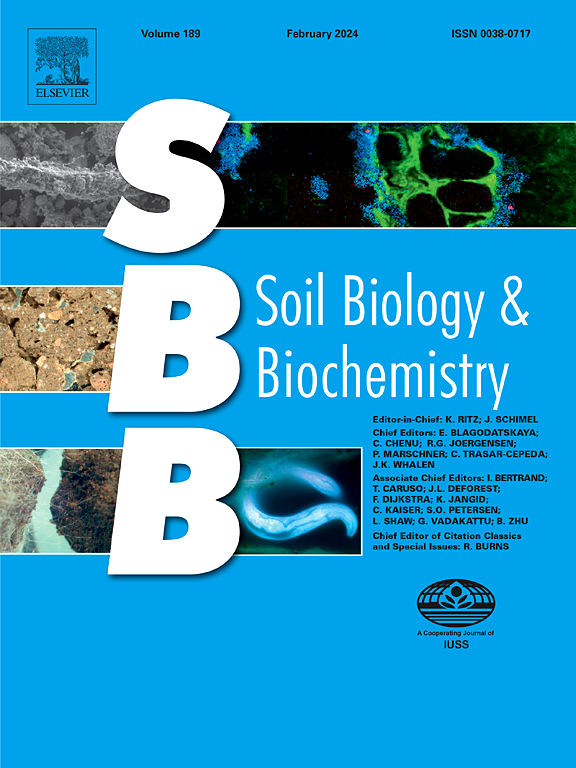Deciphering the active bacteria involving glucose-triggered priming effect in soils with gradient N inputs
IF 9.8
1区 农林科学
Q1 SOIL SCIENCE
引用次数: 0
Abstract
The soil priming effect, which refers to the alteration of soil organic matter (SOM) decomposition due to labile carbon (C) inputs, is widely acknowledged for its impact on C storage in terrestrial ecosystems. However, the impact of chronic nitrogen (N) fertilizer on soil priming effect, particularly in agroecological systems, remains unclear. Here, we utilized soils subjected to varying levels of N fertilization (0, 140, 280, 470, and 660 kg N ha−1 y−1), which were collected from a long-term experimental site. Enzyme activity related to C, N, and phosphorus (P) acquisition was measured using the fluorometric method. Additionally, DNA-based stable isotope probing with 13C-labeled glucose was conducted to explore the role of active bacterial communities (16S rRNA gene analysis) on the priming effect in soils with different N fertilization histories. Glucose addition enhanced the decomposition of native SOM and induced positive priming effects in all soils, which were amplified by the historical N application level. Activity of C-related enzymes essential for soil C decomposition increased following glucose addition, which was positively correlated with the soil priming effect. Active bacterial taxa, primarily Firmicutes, Actinobacteria, and Proteobacteria, were capable of assimilating exogenous glucose-C or native SOM-C. Notably, bacteria assimilating glucose exhibited higher abundance-weighted average ribosomal RNA gene operon copy number than those assimilating SOM, indicating the role of r-strategists in accelerating SOC turnover and increasing C loss. These findings highlight the role of active microbial community attributes on the soil priming effects. This study provides new insights into the intricate processes of C transformation in soils subjected to long-term N management in agroecosystems.
解密有氮梯度输入的土壤中涉及葡萄糖触发引物效应的活性细菌
土壤诱导效应是指由于可变碳(C)的输入而改变土壤有机质(SOM)的分解,它对陆地生态系统中 C 储存的影响已得到广泛认可。然而,长期施用氮肥对土壤初始效应的影响,尤其是在农业生态系统中的影响,仍不清楚。在这里,我们利用了从一个长期实验地采集的不同施氮水平(0、140、280、470 和 660 kg N ha-1 y-1)的土壤。采用荧光测定法测量了与碳、氮和磷(P)获取相关的酶活性。此外,还用 13C 标记的葡萄糖进行了基于 DNA 的稳定同位素探测,以探索活跃细菌群落(16S rRNA 基因分析)在不同氮肥施用历史的土壤中对引诱效应的作用。在所有土壤中,葡萄糖的添加都促进了原生 SOM 的分解,并诱导了积极的引诱效应,这种效应随着历史氮肥施用水平的提高而扩大。添加葡萄糖后,土壤中 C 分解所必需的 C 相关酶的活性增加,这与土壤的启动效应呈正相关。活跃的细菌类群(主要是固氮菌、放线菌和变形菌)能够同化外源葡萄糖-C 或本地 SOM-C。值得注意的是,与同化 SOM 的细菌相比,同化葡萄糖的细菌表现出更高的丰度加权平均核糖体 RNA 基因操作子拷贝数,这表明 r-strategists 在加速 SOC 转化和增加 C 损失方面的作用。这些发现凸显了活跃的微生物群落属性对土壤引诱效应的作用。这项研究为了解农业生态系统中长期氮管理土壤中复杂的碳转化过程提供了新的视角。
本文章由计算机程序翻译,如有差异,请以英文原文为准。
求助全文
约1分钟内获得全文
求助全文
来源期刊

Soil Biology & Biochemistry
农林科学-土壤科学
CiteScore
16.90
自引率
9.30%
发文量
312
审稿时长
49 days
期刊介绍:
Soil Biology & Biochemistry publishes original research articles of international significance focusing on biological processes in soil and their applications to soil and environmental quality. Major topics include the ecology and biochemical processes of soil organisms, their effects on the environment, and interactions with plants. The journal also welcomes state-of-the-art reviews and discussions on contemporary research in soil biology and biochemistry.
 求助内容:
求助内容: 应助结果提醒方式:
应助结果提醒方式:


